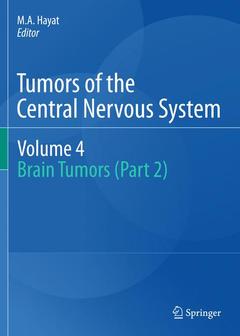Tumors of the Central Nervous System, Volume 4, 2012 Brain Tumors (Part 2) Tumors of the Central Nervous System Series, Vol. 4
Coordonnateur : Hayat M.A.

Introduction.-1. Epidemiology of primary brain tumors.-2. Supratentorial primitive neuroectodermal tumors.-3. Adult neurogenesis in etiology and pathogenesis of alzheimer’s disease .-4. Epileptic and supratentorial brain tumors in children. Part I.tumor to tumor.-5. Breast cancer metastasis to the central nervous system.-6. Melanoma to brain metastasis: photoacoustic microscopy. Part II. Biomarkers and diagnosis.-7. Extraaxial brain tumors: the role of genetic polymorphisms.-8. Central nervous system germ cell tumor.-9. Microvascular gene changes in malignant brain tumors.-10. Role of microrna in glioma.-11.glioblastoma multiforme: cryopreservation of brain tumor-intiation cells(method).-12. Relationship between molecular oncology and radiotherapy in malignant gliomas (an overview).-13. High-grade brain tumors: evaluation of new brain lesions by amino acid pet.-14. Cyclic amp phosphodiesterase-4 in brain tumor biology: immunochemical analysis.-15. Time-resolved laser induced fluorescence spectroscopy (trlifs): a tool for intra-operative diagnosis of brain tumors and maximizing extent of surgical resection. Part III. Imaging.-16. Molecular imaging of brain tumors using single domain antibodies.-17. Quantitative analysis of pyramidal tracts in brain tumor patients using diffusion tensor imagin.-18. Differentiation between gliomatosis cerebri and low-grade glioma: proton magnetic resonance spectroscopy.-19. Peripheral nerve sheath tumors: disgnosis using quantitative fdg-pet.-20. Tumor resection control using intraoperative magnetic resonance imagin.-21. Brain tumors: clinical applications of functional magnetic resonance imaging and diffusion tensor imaging.-22. Trigeminal neuralgia: diagnosis using 3-d magnetic resonance multi-fusion imaging.-23. Epilepsy-associated brain tumors: disgnosis using magnetic resonance imaging.-24. Growth OF malignant gliomas. Part IV. Therapy.-25. Resection of brain lesions: use of preoperative functional magneticresonance imaging and diffusion tensor tractography.-26. Paradigms in tumor bed radiosurgery following resection of brain metastases.-27. Rat model of malignant brain tumors: implantation of doxorubicin using drug eluting beads for delivery.-28. Electromagnetic neuronavigation for cns tumors.-29. Sterotactic radiosurgery for intracranial ependymomas.-30. Is whole brain radiotherapy beneficial for patients with brain metastases?-31. Triggering microglia ontoxicity: a bench utopia of a therapeutic approach?-32. Preoperative motor mapping.-33. Intraoperative monitoring for cranial base tumors.-34. Brain tumors: pre-clinical assesment of targeted, site specific therapy exploiting ultrasound and cancer chemotherapeutic drugs. Part V.Quality of Life.-35. Headaches in patients with brain tumors.-36. Headache associated with intracranial tumors.-37. Patients with brain cancer: health related quality of life.-38. Emerging role of brain metastases in the prognosis of breast cancer patients. Index.
Date de parution : 11-2013
Ouvrage de 386 p.
19.3x26 cm
Date de parution : 10-2011
Ouvrage de 386 p.
19.3x26 cm



